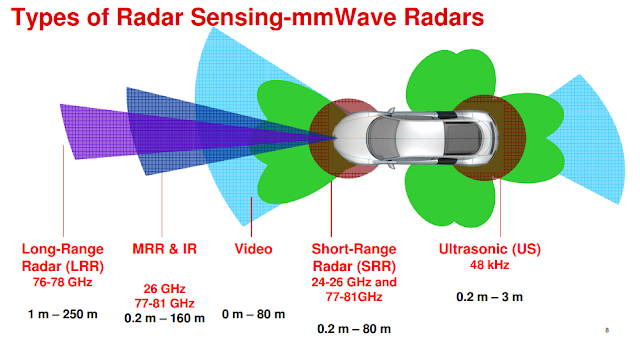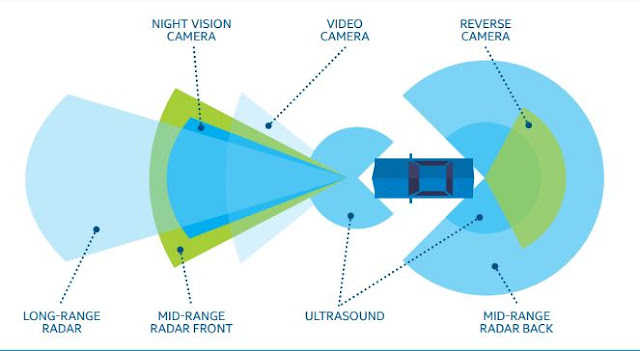Posts
Showing posts from 2018
mmwave sensing Lecture 2: The Phase of the IF Signal
- Get link
- Other Apps
Requirements for Radar System for automotives for ADAS applications
- Get link
- Other Apps
Why Radar? The radar sensor detects objects and measures their relative velocity and position. For that purpose, the sensor has four antenna elements that simultaneously transmit radar waves in the frequency range between 76 and 77 GHz. These waves are reflected by objects. By comparing the amplitudes and phases of the signal echo received by the antenna elements, precise conclusions on the objects’ position can be drawn. The relative speed and distance of objects is measured using Doppler Effect (shift in frequency between the reflected and transmitted signals) and time lag. The radar sensor can be applied to a series of functions which can also be accomplished parallell. By the identification of objects in the driveway the radar sensor is able to measure the distance and the relative speed of these objects. The subsequent object classification in relevant and non-relevant barriers enables the recognition of critical situations. The radar enables the realization of an intelli
Qualities that the Radar System Should Posses for ADAS
- Get link
- Other Apps

Qualities that the Radar System Should Posses Radar based Advanced Driver Assistance Systems (ADAS) are used to help the driver in the complex process of controlling the vehicle. Characterized by the use of short range (24GHz) and long range (77GHz) radars to analyze the environment around the car. Depending of the TX/Rx antenna position (front, rear and side), they can address the following applications: Adaptive Cruise Control (ACC) Blind-spot Detection (BSD) Emergency Braking Forward Collision Warning (FCW) Headway Alert Mitigation and Brake Support Pre-crash Detection Rear Collision Protection (RCP) Stop & Go Key Features · Ability to sweep wide RF bandwidth (GHz) while keeping IF bandwidth small (MHz) · Better range resolution. · RF sweep bandwidth of 2 GHz can achieve 7.5cm range resolution, while IF bandwidth can still be <15 MHz Performance · Range precision ∝
RADAR Systems for ADAS (Advanced Driver Assistance System)
- Get link
- Other Apps

Introduction RADAR remains the technology of choice for detection, tracking and, more recently classification of un-cooperative targets, over huge volumes of space and over the widest possible range of environmental and operational conditions.Radar is the primary sensor used to detect the vehicle's surroundings, along with the front-facing cameras. For fully autonomous driving vehicles with the security level 4 or 5 we have to the use RADAR, Camera and LIDAR systems all three together. As per the gradation of automated driving by SAE Federal Highway Research Institute, we have 6 levels, from level-0 to level-5 as stated below. Level 0: Driver only: the human driver controls everything independently, steering, throttle, brakes, etc. Level 1: Assisted driving: assistance systems help during vehicle operation (Cruise Control, ACC). Level 2: Partial automation: the operator must monitor the system at all times. At least one system, such as cruise control and lane centr
Introduction to ADAS- Advanced Driving Assistance System
- Get link
- Other Apps

ADAS system is considered as the advancement from driver assistant system (DAS). DAS is a system that informs and warns, provides feedback on actions, increases comfort, and reduces workload by actively stabilizing or maneuvering the vehicle. ADAS system is considered as a subset of DASs, with increased use of complex processing algorithms to detect and evaluate the vehicle environment based on data collected via a variety of sensor inputs. The ADAS usage cases that require full power of real-time processing and intelligence are highlighted with full stars, whereas half-colored star marked usage cases are relatively more rudimentary ADAS cases. Demand for Advanced Driver Assistance Systems (ADAS) is caused by desire to build safer vehicles and roads in order to reduce the number of road fatalities and by legislation in the leading countries. ADAS is made of the following physical sensors: radar, LIDAR, ultrasonic, photonic mixer device (PMD), cameras, and nightvision devices—tha
Introduction to Blog
- Get link
- Other Apps
Hey Everyone! This blog will be entirely on the Advanced Driving Assistance System and other technologies in the field of Autonomous Driving. I’m a RADAR Engineer and currently working Radar System Design for Autonomous Vehicles. I’ll try my best to share as much knowledge and resources that I have which you may find helpful if you working in the same field. Happy to get your feedback and suggestion or any questions.